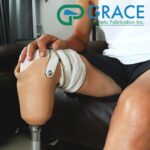What exactly is phantom pain?
When a person is suffering from phantom pain, it means that he or she feels pain from a body part that is no longer present. Although this was once thought to be a very rare condition, it’s now understood to be experienced by the majority of people who have gone through limb amputation.
When dealing with patients who have lost a body part, whether it’s a lower or upper extremity, there’s a very good chance that they’ll deal with some degree of phantom pain. Today, we’re going to go over some basic details about this medical condition. What are the various types of treatments that may provide them with some level of relief?
What Causes Phantom Pain?
Although we’ve expanded our understanding of phantom pain, we still haven’t figured out exactly what causes it. One of the leading explanations is that nerves in your brain and spinal cord are somehow “rewired” once they lose a signal from an appendage that’s been amputated.
This produces pain signals, which is the normal response that your body produces when it senses that something is wrong. Other possible causes include central sensitization, where a person becomes more sensitive to pain, and the effects of certain diseases.
What Does Phantom Pain Feel Like?
We’ve all felt different types of pain. From the throbbing of a headache to the sharp pain of being cut with something. Phantom pain can also present itself in different ways, depending on the person. Some people experience a mild burning sensation that’s just a bit uncomfortable, while others report shooting pains in the area of the missing limb.
Other phantom sensations include “pins and needles,” twisting, crushing, or even a feeling that’s akin to an electric shock. These pains can run the gamut from mild to severe. In addition to feelings of pain, a patient may feel other sensations such as movement, temperature, pressure, vibration, itching, etc.
How Does Phantom Pain Relate to Prosthetics?
Many people who experience phantom pain following an arm or leg amputation are a bit apprehensive about using a prosthetic because they think the pain will worsen. The good news is that the opposite is true.
Even though the use of a prosthetic isn’t a cure for the pain, it’s been shown that wearing a prosthetic will often reduce the pain’s severity. The reason for this isn’t exactly clear. It could be that the prosthetic makes your brain think that your original limb is still intact, which causes it to produce fewer pain signals.
What Are the Treatments for Phantom Pain?
While it’s true that prosthetics have been shown to relieve this form of pain, they haven’t been presented as a cure. This is why it’s important for patients to consider other avenues of phantom pain relief. These treatments have also shown promise for all levels of phantom pain:
- Pain Medication — As with other sources of pain, medications are often prescribed. With phantom pain, patients typically use non-steroidal anti-inflammatory drugs, which have shown some success. In more severe cases, a patient may be given opioids, though there’s a risk of dependency.
- Nerve Stimulation — If phantom pain is severe, a patient may be provided with a nerve stimulation device. These devices deliver electrical signals to their nerves, which can reduce the amount of pain they’re experiencing. These have become increasingly common for easing phantom pain for prosthetics patients.
- Antidepressants — Another possible cause of phantom pain is central sensitization, which is a process where a person’s body becomes more sensitive to pain. Antidepressants have been shown to be effective in reducing this process. Moreover, these types of medications can help counteract the negative mental health effects of dealing with phantom pain.
- Other Medications — There are a variety of other medications that have proven effective in treating phantom pain. These include topical creams and beta blockers. The results can differ depending on the person, but they’re definitely worth a try.
- Mirror Therapy — When someone is introduced to mirror therapy, they often think it’s a bit strange until they realize how effective it can be. In this form of therapy, a person looks in a mirror at their intact limb while performing exercises. This can sometimes make a person’s brain believe that both limbs are intact, which can reduce their pain level.
- Virtual Reality — Doctors have been using virtual and augmented reality for the past several years to treat various ailments. This is similar to mirror therapy except that it uses a computer simulation to make a person think that an amputated body part is still there. Few studies have been done on this particular therapy, but theoretically, it should be an effective treatment for the future.
- Alternative Therapy — There are several different types of alternate therapies that may be suggested to deal with this form of pain. This may include biofeedback, acupuncture, acupressure, or similar interventions. They have differing levels of success, depending on the patient.
- Additional Surgery — In some rare cases, a person might find relief from pain by having additional surgery. This is usually a last resort because other treatments haven’t worked. If this is the route that needs to be taken, your doctor will go over all of the potential risks and rewards.
Contact Grace to Learn More About Prosthetics and Phantom Pain
Grace Prosthetic Fabrication is a leader in the prosthetic and orthotic industries. If you would like to know more about our products, give us a call at (800) 940-5347 today.






